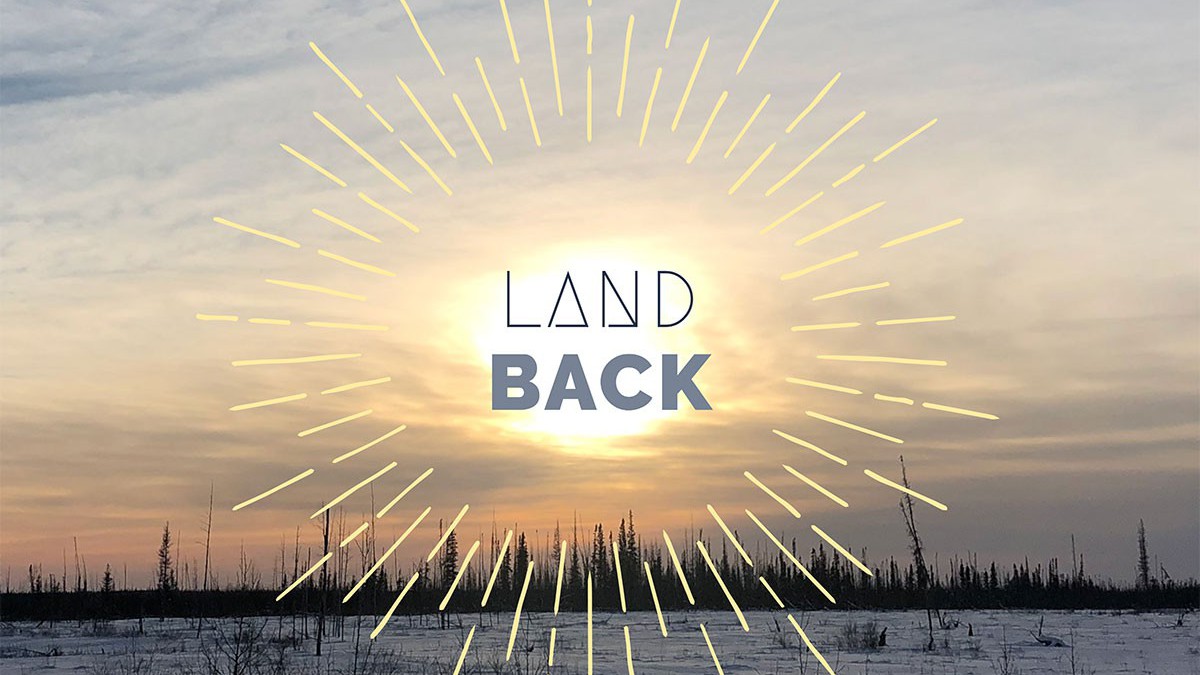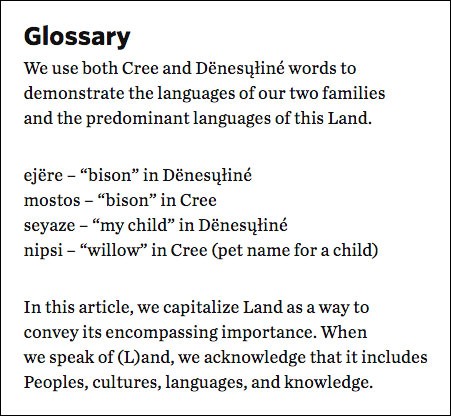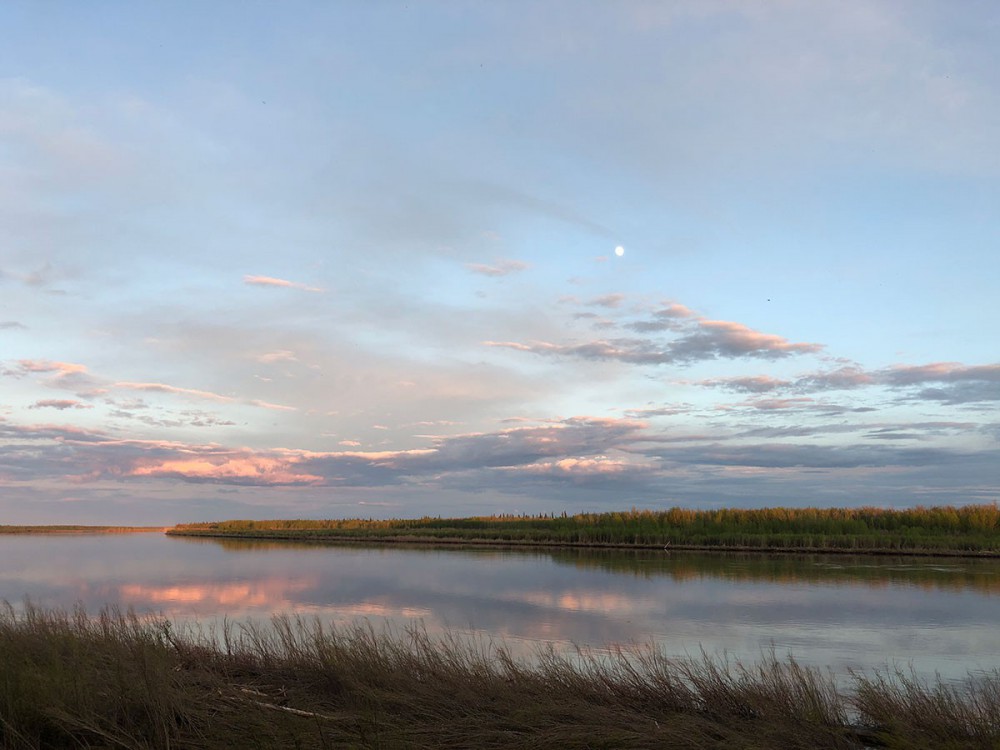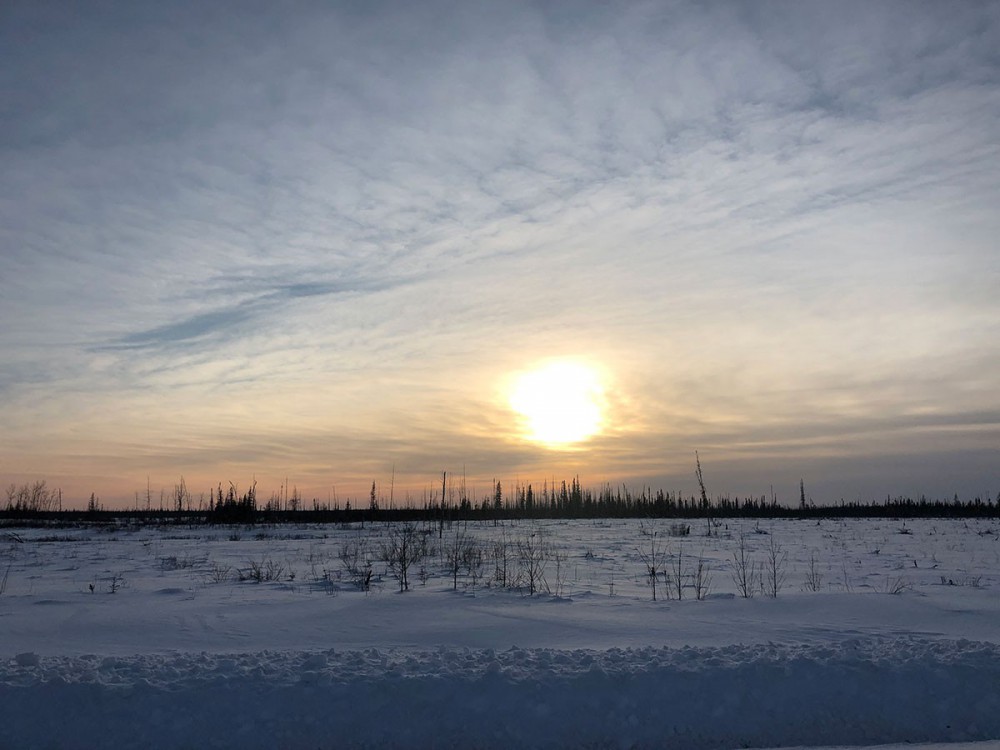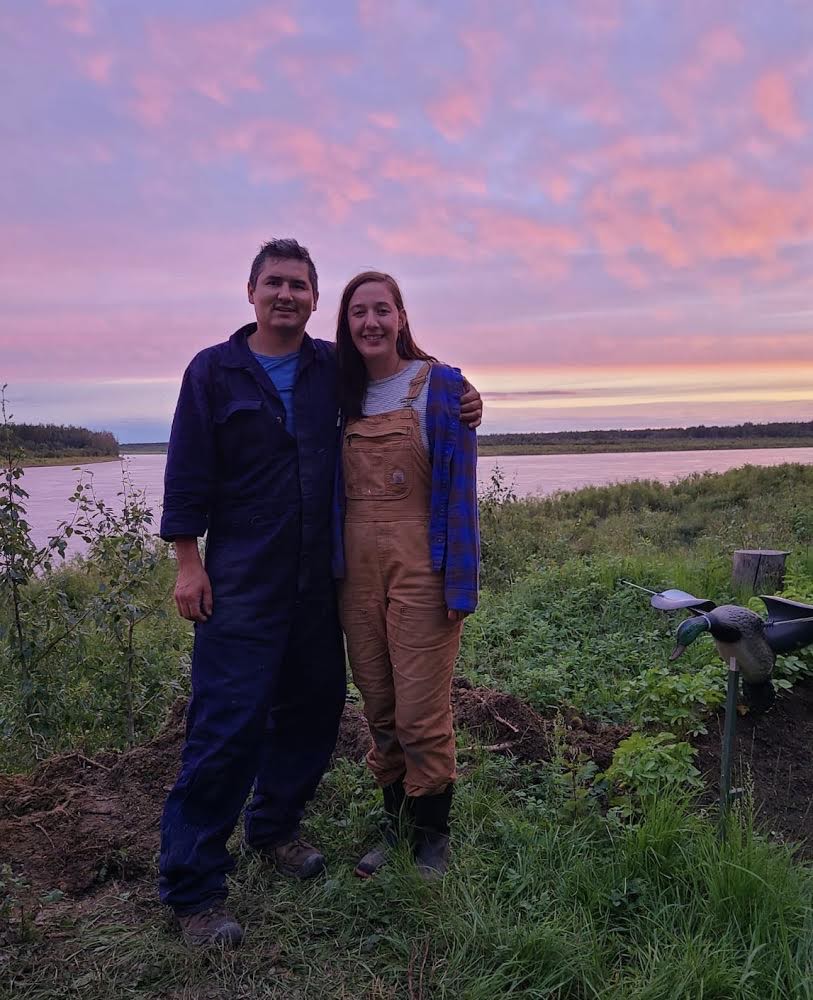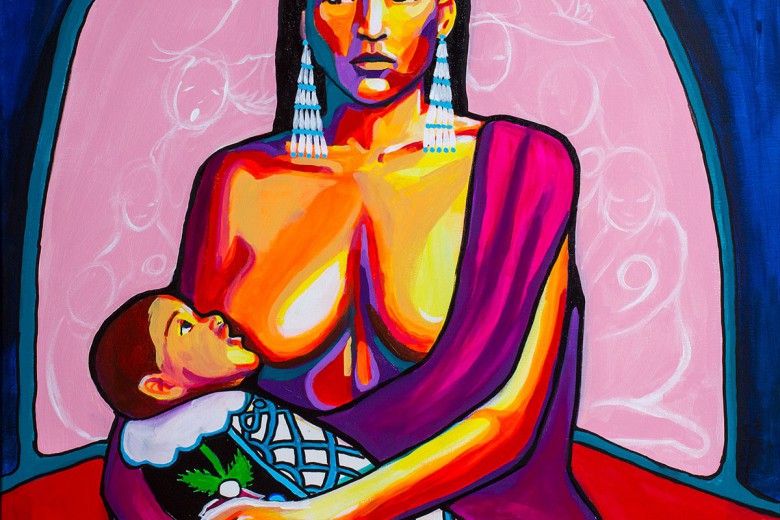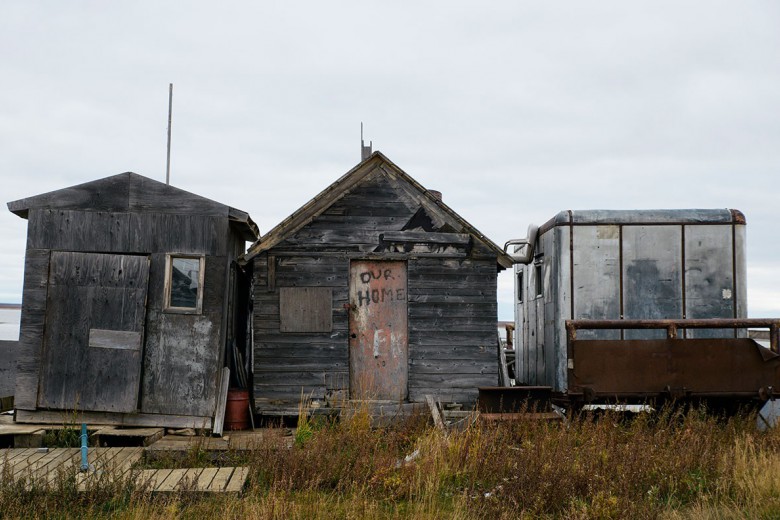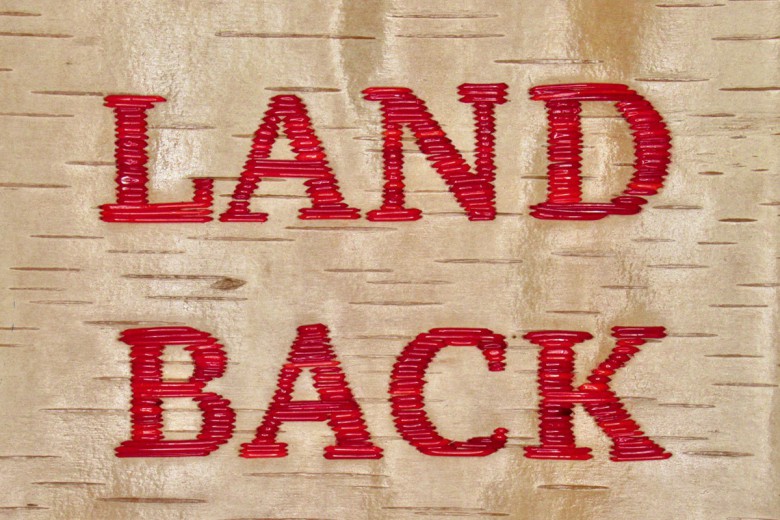Standing on the shores of Pine Lake, the wind ruffles my hair, rippling the surface of the water with the same gentle tendrils that envelop my body. We are one, the lake and I. We always have been, and we always will be. The contentment of being together again fills every cell in my body and manifests in a deep breath – of knowledge, time, and love. I look around and I see my home. I see the rocks and soils that carried my ancestors with grace. I see the trails of the bison that fed us and kept us warm. I see the temples where we prayed. Family who had long passed and were buried, they are here still.
Pine Lake is an oasis, a clear turquoise gem of an inland lake surrounded by thousands of kilometres of boreal forest. It’s hard to imagine that violence occurred here, but it did. Some of it was obvious, but much of it was insidious, the kind that wears you down over time. My journey back home took generations and it took casualties … however….
In Wood Buffalo National Park, we are now home.
After more than a century of outside control on the Lands of our ancestors, the colonial model of national parks was finally overturned in the largest park in Canada, Wood Buffalo. We did away with arbitrary borders and rigid regulations. People can breathe as part of the Land once again. Here’s a cup of tea, dear seyaze – let me tell you how we did it.
First came the reckoning.
It can be difficult to reflect on our own wrongdoings and how they hurt others. This takes tremendous strength for anyone. You will learn this as you get older, sweet nipsi – it is a hard lesson that we all have to go through in order to grow. For taking this step, and admitting their wrongs, we are proud of the institution of Parks Canada. It was many years ago, in the year 2021 – 99 years after the establishment of Wood Buffalo National Park – when Parks Canada and the Government of Canada apologized.
As part of this apology, Parks Canada travelled to each of the 11 Indigenous Nations, councils, and locals who call this Land their traditional home. They shared their vulnerability as an institution, but also held themselves accountable for their actions as individuals with free will. They acknowledged the injustices that they carried out as an arm of the colonial system of governance. They called each injustice by name.
It is not out of bitterness or hatred that I share this history with you, seyaze; knowing what happened is part of the healing process.
Parks Canada began by apologizing for the trauma they inflicted when they created the park in 1922. The park was established with the mandate of “offer[ing] a variety of visitor experiences,” but it was not in collaboration with the people on the Land. The entire concept of the park was imagined within a colonial mindset, which meant that our Indigenous systems never did fit the mould. Much like a museum exhibit, parks were meant to be preserved and admired, but not wholly participated in. That didn’t leave much room for us, the people who lived here.
Indigenous Land-users spoke of a culture of fear instilled by park management practices – we learned to hide our guns and remove the feathers from our hats when the Parks Canada wardens came.
In fact, many of us were banished from the park, some even jailed for practising our ways of life, like hunting, trapping, and fishing. Indigenous Land-users spoke of a culture of fear instilled by park management practices – we learned to hide our guns and remove the feathers from our hats when the Parks Canada wardens came. People on the Land were discouraged, shut out, and purposefully tangled in red tape up until 2021. These rules were written into Canadian law and Parks Canada regulations, so there was no disputing them. For 99 years, it felt like death by a thousand cuts.
These are the reasons it took such an effort to get people back on the Land, like we see today. I know it’s hard to imagine now, but up until 2025, there weren’t many of us left at all. This wasn’t by accident, seyaze. Our families lived through three generations of systemic obstacles to playing a role in the park’s care. Our cabin applications were denied, and cabins were even dismantled by Parks Canada. There were strict rules around what animals we could harvest, how, when, and where. Though there were trapping areas designated by the government, this wasn’t our way and there were almost no active trappers remaining by 2020. When we were barred from accessing our traditional lands – for which we had a responsibility to care – we were forced to hunt and trap on others’ traditional lands. This caused terrible division. Anyone who managed to live or harvest in the park had to be strong, for they had much to overcome.
Another piece of Parks Canada’s apology had to do with the bison. One of the original inhabitants of the park were wood bison – they differ from plains bison on the Prairies. You can recognize a wood bison, nipsi, for wood bison are truly massive, with rugged humps on their backs. Because of their prominence in this area, the park was named Wood Buffalo National Park (although, as we know, “buffalo” is not the right term, since buffalo come from South Asia and Africa!). No matter what we call them today – “bison” in English, “ejëre” in Dënesųłiné, “mostos” in Cree – they have been important for our people since time immemorial. The way we protect ejëre is by maintaining a healthy relationship with them – understanding that our fate is tied to theirs and being part of one another’s lives. This includes harvesting ejëre for food and all we do, including ceremony.
Parks Canada also sold mostos for meat until the early 1970s. They herded animals into pens, and many died in the process. Of the mostos that survived, an estimated 4,000 were slaughtered and sold down south.
Fundamentally, protection means having people out on the Land.
I know you’re aware, my nipsi, that the ejëre went through much turmoil under the governance of Parks Canada as well. Part of that was because the harvesting of ejëre was not permitted in the park until 2021, and, at times, Indigenous Peoples were prosecuted and expelled from the park for their harvests. Outside the park boundary though, anyone who wanted to shoot ejëre east of Highway 35 in Alberta, could. This is the utter madness of colonial borders.
Between 1925 and 1928, plains mostos were introduced in an effort to increase the number of animals in Wood Buffalo National Park. This brought disease – tuberculosis and brucellosis – which killed many of the native wood mostos. The herds of plains and wood mostos intermingled, producing a hybrid species. Parks Canada also sold mostos for meat until the early 1970s. They herded animals into pens, and many died in the process. Of the mostos that survived, an estimated 4,000 were slaughtered and sold down south. More were culled afterward, to try to eliminate the disease that was brought in. Because of the declining numbers of mostos, wolves were poisoned to try to lower the number of wolf kills. This did not help, as poison seeped into the ecosystem, affecting everyone and everything in the park – including mostos.
We know now that the treatment of Land, Peoples, and mostos was part of a larger governance approach aimed at control and commodification.
I know it hurts to hear these stories, my darling nipsi. It hurts me too to hear how ejëre have been treated here, and even more so when the injustices that were carried out against us were in the name of protecting ejëre.
It was never about the bison.
We know now that the treatment of Land, Peoples, and mostos was part of a larger governance approach aimed at control and commodification. Logging was carried out on traditional lands in the park and lumber was sold to support exploration and mining in Uranium City. Commercial fishing was permitted on Lake Claire within the park boundary. Profits did not go to the Indigenous communities in the park, where they could have created circular reciprocity with the Land. Some will say this all happened a long time ago, but remember, these were not isolated events. Up until 2021, injustice changed shape, but it did not go away. Always look at the big picture, my sweet seyaze. It’s not that commercial activity is a bad thing, but any activity without notions of balanced, local economies is bound to affect abundance over time.
The Land is rich, and it wasn’t long before big resource extraction projects nudged up against the boundaries of the park. When the wind blew from the south, you could smell the foul odour of sulphur from the tarsands and see a haze in the distance. Even when we melted winter snow for drinking and other uses, we saw a sheen on the surface of the water. The threat of Teck Resources’ Frontier mine – one of the largest open-pit tarsands mines ever proposed – loomed 30 kilometres south of the park, until it was (at least temporarily) defeated in 2020. The Site C dam, along with climate change and withdrawals of water from the Athabasca River, further dried up the waters of the Peace-Athabasca Delta. When the waters were low, it became difficult for us to travel along the rivers and lakes. Three dams along the river all released or retained water at will, making water levels and erosion patterns unpredictable.
Until the apology of 2021, the park was treated as a thing to be owned by Parks Canada – it was not self-determined, living, breathing Land the way we know it to be. With this mindset, it could be pieced away as different assets – for conservation, environment, commerce, or anything else. That’s right, seyaze. Parks was trying to protect Land with the same mindset that caused the problem. That’s why so many things went wrong under its care. For us, the Land never could be owned or categorized, nor could it be separated from people. The way Parks Canada understood “effective protection” of the Land was not the same way that we did.
So, along with Parks Canada’s apologies came their recognition of the true guardians of this Land. Recognition that – before Canada stepped in – this area had been governed successfully for millennia by people on the Land, through holistic and cumulative worldviews and our own dynamic laws. They recognized that all our systems were built to work with the plants, animals, waters, rocks, and thick delta mud of this specific Land. They expressed deep sorrow for the loss of knowledge that had occurred over 99 years. They promised to do whatever they could to support us in rebuilding our systems. Because of Parks Canada’s authentic apologies and recognition, your ancestors decided to restart the conversation about solutions.
After agreeing to work together, the next step was to address the condition of the park. A century without proper care had left the Land in a dire state. In 2020, we saw declining numbers of mostos and wolves – the same species that the park was established to “protect” in the first place. Forest fires had been burning out of control, and invasive species were moving in. People had been almost completely removed. Without people on the Land, there was no way to stop, or even notice and understand, the deteriorations. UNESCO’s World Heritage Committee warned that if actions were not taken to improve the situation, the park was to be placed on their site List of World Heritage in Danger. From every perspective, it was clear that we were at an all-time low.
How could we work together to build abundance once again?
For us, the Land never could be owned or categorized, nor could it be separated from people. The way Parks Canada understood “effective protection” of the Land was not the same way that we did.
Luckily, neither we nor our kin across the continent ever remained idle. In 2018, a passionate and dedicated committee developed recommendations for Indigenous Protected and Conserved Areas (IPCAs). IPCAs, by definition, are Lands that are governed by local Indigenous communities, according to their own laws and knowledge systems. Parks Canada supported this process from the beginning.
We decided there were steps we could take to listen to the Land and to each other once again. We could use IPCA models to rebuild Wood Buffalo from the inside out, with love.
As you know, my nipsi, we now call this governance system the Ejëre Mostos Relational Alliance in honour of our new-old governance approach. It wasn’t hard to bring the people together – though for a time, it seemed as if it might be. Canada’s politics of division tore us apart for many years, as they have all over Indian country. Once our leaders recognized what we had in common – namely, our struggles with Parks Canada and other Crown agencies – we were able to turn negative attention away from each other and move forward very quickly.
Instead of focusing on our individual rights, we were reminded of our collective responsibility to the Lands we share. We realized that we had no obligation to carry on as we had been doing, and with that we overcame the unhealthy jealousy, greed, and hierarchy that had poisoned our relationships for over 100 years.
In the Alliance, each of the 11 Nations, councils, and locals who call this Land their home now govern together. We have developed a network of overlapping IPCAs within the park boundaries. Each one works not according to colonial borders, but with the contours of the Land. We each take primary responsibility for the areas closest to us. Guardians and Land users are the heartbeat of the system. They move as the bison do, informing the collective Alliance of what needs to be done to create and maintain abundance. In this way, while we govern the Land, we do not own it.
The Land tells us what needs to be done, and ultimately, our responsibilities are to listen and participate. We are all bound by the laws of the Land.
The laws protecting the park through Canada’s National Parks Act remain; however, they are one layer of legislation that functions alongside – but cannot override – the Indigenous laws of the IPCAs. None of the Nations have veto power, either, and we must work through our disagreements by consensus. This can take a long time, but it is in everyone’s best interest to find ways forward. We strive always for an ethical space of engagement, where our laws and our ways of knowing, doing, and thinking work respectfully alongside one another, never impeding or superseding each other. The Land tells us what needs to be done, and ultimately, our responsibilities are to listen and participate. We are all bound by the laws of the Land.
Today, instead of “bilateral” meetings with Parks Canada, all of the 11 Nations, councils, and locals meet with one another whenever needed. This is important, because to be accountable, we hear what is said firsthand. When we meet, we share food and hospitality. Everything that is said is made available to the public, and we upload videos of our meetings to a website. We use new technologies to achieve the long-standing cultural value of openness. Our governance structures are not permanent; rather, they are fluid and adaptable. We establish them when needed and remove them when no longer necessary. This means leadership is never absolute. Like the Peace River, it curves and winds.
As has always been our way, we welcome all people. Parks Canada is still here, too. They bring their strengths to the table, adding their voice and expertise, but they no longer make the rules. The Alliance hires them to do specific scientific studies. They also maintain and build roads to ensure people always have access to the park. They help to build cabins for guardians and community members. We believe they are doing their best to restore equity, and when asked they carry out duties in service of the Alliance so that Indigenous Peoples have time to be on the Land.
We remove red tape. We ask Land-users what they need, and we find creative ways to support everyone through our IPCAs, no matter which family or community they come from.
It is in the name of effective governance that the Alliance prioritizes Indians on the Land, above all else. The regulations and legislation of Parks Canada were once intended to ultimately eliminate us from the Land. But we long ago recognized that the systems of colonial control and division that were suppressing our Peoples had no power if we remained present. The Land has the answers we need. And so we do everything possible to support people getting out onto the Land. We remove red tape. We ask Land-users what they need, and we find creative ways to support everyone through our IPCAs, no matter which family or community they come from.
Our goal is to create sustainable futures where our Peoples can live in two worlds – as part of the Land with all the integrity of our own systems, and part of the modern economy. Because the Land gives us the knowledge we need, it follows that people on the Land are the conduit between systems of governance, economics, health, education, and conservation. That is why guardians, trappers, hunters, gatherers, educators, and knowledge holders are essential to the success of the Alliance.
Together, seyaze, we have become the strongest “park” in Canada, because we have the advantage of diversity. We have so many different people who care. We all have our roles, our strengths, and also our weaknesses. We support each other in a messy and beautiful web of reciprocal relationships, just like the Land. And just like the Land, we cross colonial borders physically, mentally, emotionally, and spiritually. We recognize that we don’t fit within straight lines, and we must have the courage to continually cross borders to be true to our identities – being ourselves is the most basic tenet of our laws. Everything comes together on the Land, and so that is where we are now.
In Wood Buffalo National Park, we are now home.
Today, I watch my children running and playing in Pine Lake’s clear waters, our warm boreal oasis. Loving how they laugh and splash and chase each other freely, my heart aches from the weariness and also smiles with the same satisfaction of a muscle after working a long, long day. This story of reconciliation is now theirs to tell.
About the authors
Chloe Dragon Smith and Robert Grandjambe are young Indigenous northerners who are writing from Wood Buffalo National Park, at Moose Island on the Peace River, where they live. Both Chloe and Robert have ancestors who lived, harvested, ate, shared, struggled, loved, and died here, long before Canada claimed it as their park. Every day, first-hand, they experience the intergenerational effects of Parks Canada legislation, regulations, and policies on those they love. They feel these impacts themselves. They bear witness to current relations with Parks Canada, which, in their eyes, remain very unhealthy. They care deeply about this Land and the futures of their families. They will continue to live within the park, pushing boundaries for change. This visionary future for the park is alive and in progress, meaning that ideas will change and grow as time unfolds. Neither Robert nor Chloe claim to have the answers; however, regardless of the outcomes, they will still be here.
This story was financially supported by a bursary from the Journalists for Human Rights’ Indigenous Reporters Program.


